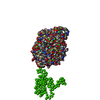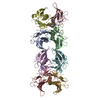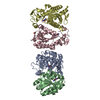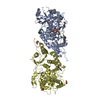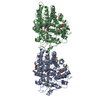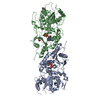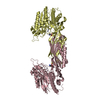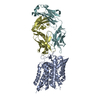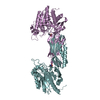[English] 日本語
 Yorodumi
Yorodumi- SASDEQ9: Cyclic GMP-AMP synthase (cGAS) with cyclic guanosine monophosphat... -
+ Open data
Open data
- Basic information
Basic information
| Entry | Database: SASBDB / ID: SASDEQ9 |
|---|---|
 Sample Sample | Cyclic GMP-AMP synthase (cGAS) with cyclic guanosine monophosphate–adenosine monophosphate (2'3'-cGAMP)
|
| Function / homology |  Function and homology information Function and homology information2',3'-cyclic GMP-AMP synthase activity / cyclic GMP-AMP synthase / STING mediated induction of host immune responses / paracrine signaling / poly-ADP-D-ribose modification-dependent protein binding / regulation of immunoglobulin production / cGAS/STING signaling pathway / regulation of T cell activation / pattern recognition receptor signaling pathway / : ...2',3'-cyclic GMP-AMP synthase activity / cyclic GMP-AMP synthase / STING mediated induction of host immune responses / paracrine signaling / poly-ADP-D-ribose modification-dependent protein binding / regulation of immunoglobulin production / cGAS/STING signaling pathway / regulation of T cell activation / pattern recognition receptor signaling pathway / : / cytoplasmic pattern recognition receptor signaling pathway / negative regulation of cGAS/STING signaling pathway / cellular response to exogenous dsRNA / positive regulation of type I interferon production / negative regulation of double-strand break repair via homologous recombination / : / nucleosome binding / positive regulation of defense response to virus by host / phosphatidylinositol-4,5-bisphosphate binding / activation of innate immune response / determination of adult lifespan / molecular condensate scaffold activity / positive regulation of cellular senescence / site of double-strand break / double-stranded DNA binding / defense response to virus / nuclear body / innate immune response / DNA repair / DNA damage response / chromatin binding / GTP binding / protein homodimerization activity / DNA binding / nucleoplasm / ATP binding / metal ion binding / nucleus / plasma membrane / cytosol / cytoplasm Similarity search - Function |
| Biological species |  Homo sapiens (human) Homo sapiens (human) |
 Citation Citation |  Journal: EMBO Rep / Year: 2019 Journal: EMBO Rep / Year: 2019Title: cGAS facilitates sensing of extracellular cyclic dinucleotides to activate innate immunity. Authors: Haipeng Liu / Pedro Moura-Alves / Gang Pei / Hans-Joachim Mollenkopf / Robert Hurwitz / Xiangyang Wu / Fei Wang / Siyu Liu / Mingtong Ma / Yiyan Fei / Chenggang Zhu / Anne-Britta Koehler / ...Authors: Haipeng Liu / Pedro Moura-Alves / Gang Pei / Hans-Joachim Mollenkopf / Robert Hurwitz / Xiangyang Wu / Fei Wang / Siyu Liu / Mingtong Ma / Yiyan Fei / Chenggang Zhu / Anne-Britta Koehler / Dagmar Oberbeck-Mueller / Karin Hahnke / Marion Klemm / Ute Guhlich-Bornhof / Baoxue Ge / Anne Tuukkanen / Michael Kolbe / Anca Dorhoi / Stefan He Kaufmann /    Abstract: Cyclic dinucleotides (CDNs) are important second messenger molecules in prokaryotes and eukaryotes. Within host cells, cytosolic CDNs are detected by STING and alert the host by activating innate ...Cyclic dinucleotides (CDNs) are important second messenger molecules in prokaryotes and eukaryotes. Within host cells, cytosolic CDNs are detected by STING and alert the host by activating innate immunity characterized by type I interferon (IFN) responses. Extracellular bacteria and dying cells can release CDNs, but sensing of extracellular CDNs (eCDNs) by mammalian cells remains elusive. Here, we report that endocytosis facilitates internalization of eCDNs. The DNA sensor cGAS facilitates sensing of endocytosed CDNs, their perinuclear accumulation, and subsequent STING-dependent release of type I IFN Internalized CDNs bind cGAS directly, leading to its dimerization, and the formation of a cGAS/STING complex, which may activate downstream signaling. Thus, eCDNs comprise microbe- and danger-associated molecular patterns that contribute to host-microbe crosstalk during health and disease. |
 Contact author Contact author |
|
- Structure visualization
Structure visualization
| Structure viewer | Molecule:  Molmil Molmil Jmol/JSmol Jmol/JSmol |
|---|
- Downloads & links
Downloads & links
-Models
| Model #2780 |  Type: mix / Radius of dummy atoms: 1.90 A / Chi-square value: 1.138 / P-value: 0.000013  Search similar-shape structures of this assembly by Omokage search (details) Search similar-shape structures of this assembly by Omokage search (details) |
|---|---|
| Model #2781 |  Type: mix / Radius of dummy atoms: 1.90 A / Chi-square value: 1.138 / P-value: 0.000013  Search similar-shape structures of this assembly by Omokage search (details) Search similar-shape structures of this assembly by Omokage search (details) |
| Model #2782 |  Type: mix / Radius of dummy atoms: 1.90 A / Chi-square value: 1.138 / P-value: 0.000013  Search similar-shape structures of this assembly by Omokage search (details) Search similar-shape structures of this assembly by Omokage search (details) |
| Model #2783 |  Type: mix / Radius of dummy atoms: 1.90 A / Chi-square value: 1.138 / P-value: 0.000013  Search similar-shape structures of this assembly by Omokage search (details) Search similar-shape structures of this assembly by Omokage search (details) |
- Sample
Sample
 Sample Sample | Name: Cyclic GMP-AMP synthase (cGAS) with cyclic guanosine monophosphate–adenosine monophosphate (2'3'-cGAMP) Specimen concentration: 9 mg/ml / Entity id: 1448 / 1449 |
|---|---|
| Buffer | Name: 20 mM HEPES / pH: 7.4 |
| Entity #1448 | Name: cGAS / Type: protein / Description: Cyclic GMP-AMP synthase / Formula weight: 61.419 / Num. of mol.: 2 / Source: Homo sapiens / References: UniProt: Q8N884 Sequence: MQPWHGKAMQ RASEAGATAP KASARNARGA PMDPTESPAA PEAALPKAGK FGPARKSGSR QKKSAPDTQE RPPVRATGAR AKKAPQRAQD TQPSDATSAP GAEGLEPPAA REPALSRAGS CRQRGARCST KPRPPPGPWD VPSPGLPVSA PILVRRDAAP GASKLRAVLE ...Sequence: MQPWHGKAMQ RASEAGATAP KASARNARGA PMDPTESPAA PEAALPKAGK FGPARKSGSR QKKSAPDTQE RPPVRATGAR AKKAPQRAQD TQPSDATSAP GAEGLEPPAA REPALSRAGS CRQRGARCST KPRPPPGPWD VPSPGLPVSA PILVRRDAAP GASKLRAVLE KLKLSRDDIS TAAGMVKGVV DHLLLRLKCD SAFRGVGLLN TGSYYEHVKI SAPNEFDVMF KLEVPRIQLE EYSNTRAYYF VKFKRNPKEN PLSQFLEGEI LSASKMLSKF RKIIKEEIND IKDTDVIMKR KRGGSPAVTL LISEKISVDI TLALESKSSW PASTQEGLRI QNWLSAKVRK QLRLKPFYLV PKHAKEGNGF QEETWRLSFS HIEKEILNNH GKSKTCCENK EEKCCRKDCL KLMKYLLEQL KERFKDKKHL DKFSSYHVKT AFFHVCTQNP QDSQWDRKDL GLCFDNCVTY FLQCLRTEKL ENYFIPEFNL FSSNLIDKRS KEFLTKQIEY ERNNEFPVFD EFLEYPYDVP DYAAAALEHH HHHH |
| Entity #1449 | Name: 2′3′-cGAMP / Type: other Description: 2'-O,5'-O-((adenosine-3'-O,5'-O-diyl)bisphosphinico)guanosine Formula weight: 0.674 / Num. of mol.: 2 Sequence: C20H24N10O 13P2 |
-Experimental information
| Beam | Instrument name: PETRA III EMBL P12 / City: Hamburg / 国: Germany  / Type of source: X-ray synchrotron / Wavelength: 0.1241 Å / Dist. spec. to detc.: 3 mm / Type of source: X-ray synchrotron / Wavelength: 0.1241 Å / Dist. spec. to detc.: 3 mm | ||||||||||||||||||||||||||||||||||||
|---|---|---|---|---|---|---|---|---|---|---|---|---|---|---|---|---|---|---|---|---|---|---|---|---|---|---|---|---|---|---|---|---|---|---|---|---|---|
| Detector | Name: Pilatus 2M | ||||||||||||||||||||||||||||||||||||
| Scan | Measurement date: Apr 25, 2017 / Storage temperature: 10 °C / Cell temperature: 20 °C / Exposure time: 1 sec. / Number of frames: 3600 / Unit: 1/nm /
| ||||||||||||||||||||||||||||||||||||
| Distance distribution function P(R) |
| ||||||||||||||||||||||||||||||||||||
| Result |
|
 Movie
Movie Controller
Controller

 SASDEQ9
SASDEQ9